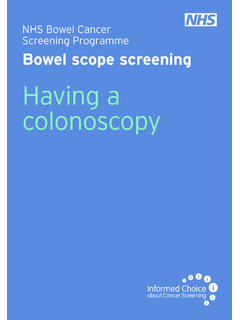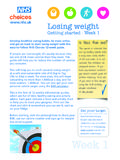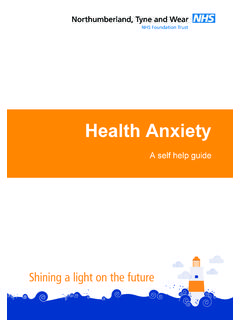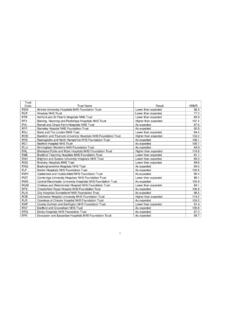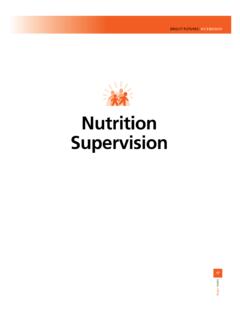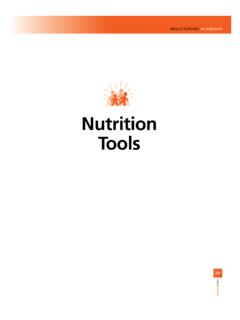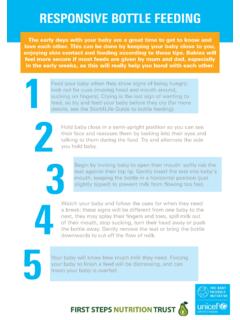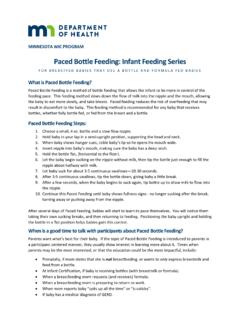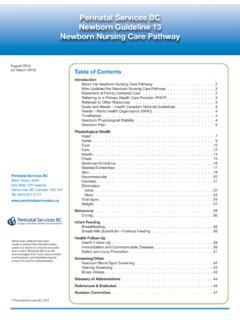Transcription of Guide to bottle feeding - NHS
1 Guide to bottle feeding How to prepare infant formula and sterilise feeding equipment to minimise the risks to your baby The Baby Friendly Initiative Contents About this 1 Whatisinfant formula ?..2 How do I choose feeding equipment? .. 5 How to sterilise feeding equipment .. 6 Howto make up feeding your Breastfeeding, giving infant formula and introducing solid About this booklet The information in this booklet comes from the Department of Health and the Food Standards Agency. It will help you minimise the risks to your baby when you prepare and give infant formula , and sterilise equipment. It is very important that you follow the instructions in this booklet when you are: preparing infant formula feeds; sterilising feeding bottles; and sterilising feeding equipment. If you need more information about bottle feeding your baby, speak to your midwife, health visitor or GP. 1 What is infant formula ? infant formula is made from cow s milk that has been treated to make it suitable for babies.
2 There are a number of different brands in the shops that meet the required legal standards. The cow s milk in infant formula contains a mix of two types of proteins whey and casein. Different types of infant formula infant formula is available in two forms: ready-to-feed liquid infant formula , sold in cartons, which is sterile; and powdered infant formula , which is not sterile. First infant formula This is often described as suitable for newborns. It is based on the whey of cow s milk and is thought to be easier to digest than other types of infant formula . This should always be the first formula you give to your baby. Unless your midwife, health visitor or GP suggests otherwise, this is the only infant formula your baby needs. Your baby can stay on this formula when you start to introduce solid foods at around six months, and continue on it throughout the first year. When your baby is one year old, they can start to drink whole cow s milk.
3 There is no evidence to suggest that changing the brand of infant formula your baby drinks does any good or harm. However, if you think a particular brand of infant formula disagrees with your baby, try another. Your midwife or health visitor will be able to discuss this with you. 2 Casein based infant formula infant formula that is mostly based on casein is thought to take your baby longer to digest than whey-based formula . It is not recommended for young babies. There is little nutritional difference between this formula and first infant formula . Although it is often described as suitable for hungrier babies there is no evidence that babies settle better or sleep longer when fed this formula . Follow-on formula This is also casein based and should never be fed to babies under six months of age. Research has found no clear benefit from its use. However, the labels on this formula can look very similar to those on first infant formula , so read them carefully to avoid making a mistake.
4 Other formulae Some follow-on formula has cereal added to it, and is described as a night- time feed for babies . This type of formula is not necessary and there is no evidence that babies settle better or sleep longer when fed this. It should never be given to babies under six months. Soya infant formula is made from soya beans, not cow s milk. Do not use soya formula unless it has been prescribed or recommended by your GP. If your baby is diagnosed as being allergic to cow s milk, your GP will prescribe an appropriate infant formula with fully hydrolysed proteins. infant formula with partially hydrolysed proteins is available in the shops, but this is not suitable for babies with a cow s milk allergy. 3 Remember, if you have any questions about the infant formula you are giving your baby, you can ask your midwife, health visitor or GP for information and help. KEY FACTS: Types of milk to avoid Not all milk is suitable for feeding babies.
5 Here are some of the types of milk you should never give to a baby under one year: Condensed milk Evaporated milk Dried milk Sheep s milk Goat s milk Other types of drinks known as milks such as rice, oat or almond drinks Cow s milk as a drink. 4 How do I choose feeding equipment? There is a large variety of feeding equipment available in shops. You will need a number of bottles and teats, as well as sterilising equipment to keep them clean. feeding teats can be made from rubber or silicone and vary in shape. There is no evidence that one teat is better than another. You can try different teats and use the one that suits your baby best. feeding bottles are made of food-grade plastic. However, some shapes and patterns on bottles can make them difficult to clean. A simple, easy-to-clean bottle is best. 5 How to sterilise feeding equipment There are several ways in which you can sterilise your baby s feeding equipment, such as: using a cold water sterilising solution; steam sterilising; and sterilising by boiling.
6 The following instructions apply to all feeding equipment you use for your baby whether you are using expressed breast milk or infant formula . Before sterilising, always clean and rinse Clean the feeding bottle and teat in hot, soapy water as soon as possible after a feed, using a clean bottle brush. Rinse all your equipment in clean, cold running water before sterilising. Cold water sterilising solution Follow the manufacturer s instructions. Change the sterilising solution every 24 hours. Leave feeding equipment in the sterilising solution for at least 30 minutes. 6 Make sure that there is no air trapped in the bottles or teats when putting them in the sterilising solution. Keep all the equipment under the solution with a floating cover. KEY FACT: All feeding items must be washed and rinsed before they are sterilised. It is important to follow the instructions that come with your steriliser. Steam sterilising (electric steriliser or microwave) As there are different types of sterilisers it is important to follow the manufacturer s instructions.
7 Make sure the openings of the bottles and teats are facing down in the steriliser. Manufacturers will give a Guide as to how long you can leave equipment that you are not using straight after sterilising before it needs to be resterilised. 7 Sterilising by boiling When using this method, care must be taken to ensure safety and prevent scalds or burns. Hot pans and liquids should not be left unattended, especially if children are present. Make sure that whatever you sterilise in this way is safe to boil. Boil the feeding equipment in water for at least 10 minutes, making sure that all items stay under the surface of the water. Remember that teats tend to get damaged faster with this method. KEY FACTS: Be careful to prevent anyone, especially children, from being burned or hurt if you are using the boiling method. Regularly check that teats and bottles are not torn, cracked or damaged. Wash hands thoroughly. Clean and disinfect the surface where you will put together the bottle and teat.
8 It is best to remove the bottles just before they are used. If the bottles are not being used immediately, they should be put together fully with the teat and lid in place to prevent the inside of the sterilised bottle and the inside and outside of the teat from being contaminated. 8 How to make up a feed Bacteria in infant formula Even when tins and packets of powdered infant formula are sealed, they can sometimes contain bacteria such as Cronobacter sakazakii (formerly know as Enterobacter sakazakii) and more rarely Salmonella. Although these bacteria are very rare, the infections they cause can be life-threatening. To reduce the risk of infection, make up each feed as your baby needs it, using boiled water at a temperature of 70oC or above. Water at this temperature will kill any harmful bacteria that may be present. KEY FACTS: Make up feeds, one at a time, as your baby needs them. Always use boiled water at a temperature of at least 70oC, but remember to let the feed cool before you give it to the baby.
9 9 Bacteria multiply very fast at room temperature. Even when the feed is kept in a fridge, bacteria can still survive and multiply, although they do this more slowly. The risk of infection increases over time so that is why it is important to make up the feed only as your baby needs it. Preparation and hygiene A baby s immune system is not as strong nor as well developed as an adult s. This means that babies are much more susceptible to illness and infection. Therefore, good hygiene is very important when making up a feed. All equipment used to feed your baby must be sterilised. Bottles, teats and any other feeding equipment need to be cleaned and sterilised before each feed to reduce the chances of your baby getting sickness and diarrhoea. It is best to use boiled drinking water from the tap to make up a feed. Do not use artificially softened water or water that has been previously boiled. 10 Bottled water Bottled water is not recommended to make up a feed as it is not sterile and may contain too much salt (sodium) or sulphate.
10 If you have to use bottled water to make up a feed, check the label to make sure the sodium (also written as Na) level is less than 200 milligrams (mg) per litre, and the sulphate (also written as SO or SO4) content is not higher than 250 mg per litre. It is not usually sterile so it will still need to be boiled, like tap water, before you prepare the feed. KEY FACT: Always use freshly boiled water to make up a feed. 11 A step-by-step Guide to preparing a powdered- formula feed Step 1: Fill the kettle with at least 1 litre of fresh tap water (don t use water that has been boiled before). Step 2: Boil the water. Then leave the water to cool for no more than 30 minutes so that it remains at a temperature of at least 70oC. Step 3: Clean and disinfect the surface you are going to use. Step 4: It s really important that you WASH YOUR HANDS. Step 5: If you are using a cold-water steriliser, shake off any excess solution from the bottle and the teat, or rinse the bottle with cooled boiled water from the kettle (not the tap).
